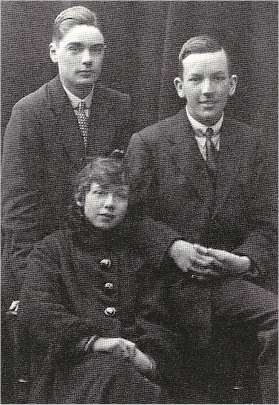Esmé Wynne-Tyson facts for kids
Quick facts for kids
Esmé Wynne-Tyson
|
|
|---|---|

Esmé Wynne-Tyson in 1916 with fellow actors, John Ekins (left) and Noël Coward
|
|
| Born |
Esmé Wynne
29 June 1898 London, England
|
| Died | 17 January 1972 (aged 73) Chichester, England
|
| Occupation | Actress, writer and philosopher |
| Spouse(s) |
Linden Charles Tyson
(m. 1918; div. 1947) |
| Children | Jon Wynne-Tyson |
Esmé Wynne-Tyson (born June 29, 1898 – died January 17, 1972) was an English actress, writer, and thinker. As a child, she performed in plays in London's West End. She became a very close friend and helper of the famous writer and actor Noël Coward. She stopped acting in 1920 and started writing many novels. Later, she became very interested in spiritual and moral topics, which led her to write non-fiction books and newspaper articles. She often worked with the writer J. D. Beresford.
Contents
About Esmé Wynne-Tyson
Her Early Life and Acting
Esmé Wynne-Tyson was born Dorothy Estelle Esmé Innes Ripper in Stockwell, London. She was the only child of Harry Innes Ripper, who worked in finance, and Minnie Maude Pitt. She was educated at home by teachers and later at schools in England and Belgium.
In 1909, she started acting as a child and chose the stage name Esmé Wynne. Her first professional acting job was in a play called The Blue Bird. In 1911, she was the first actress to play Rosamund in Where the Rainbow Ends. While working on this play, she became good friends with a young Noël Coward, who was also in the show. Their friendship was very important to Coward for a long time.
Esmé also started writing plays, sometimes by herself and sometimes with Coward. Her first play, The Prince's Bride, was put on stage when she was just 13 years old. The famous director Charles Hawtrey produced it at the Savoy Theatre in London, and Coward was even in the cast! At 19, she wrote a light comedy called Little Lovers, which was performed in London in 1922, but it didn't get very good reviews. With Coward, she wrote several short plays using the shared pen-name "Esnomel." Her last time on stage was in Coward's comedy I'll Leave It to You in 1920, where she also helped write song lyrics.
Her Writing Journey
In 1918, Esmé married Linden Charles Tyson, who was an officer in the Royal Air Force. The next year, they combined their last names to "Wynne-Tyson." They had one son, Jon Wynne-Tyson, who later became a writer and publisher himself.
After her marriage, Esmé became very interested in spiritual ideas and healthy living, like vegetarianism. This made her less interested in the theatre world. However, she remained friends with Noël Coward, who found her attempts to make him more "moral" quite funny.
In the years after her marriage, Wynne-Tyson wrote several novels: Security (1927), Quicksand (1927), Momus (1928), Melody (1929), and Incense and Sweet Cane (1930). These books often included parts of her own life, showing how her marriage was changing and how she was becoming more religious. Her marriage ended in 1930, and they officially divorced in 1947.
After her separation, she started writing non-fiction books and articles for newspapers, as well as more stories. She often worked with J. D. Beresford, who shared her interest in deep ideas and a belief she called "philosophy of compassion." They wrote ten novels together, though some were published under Beresford's name for business reasons. Some of their official joint books include Strange Rival (1940), Men in the Same Boat (1943), The Riddle of the Tower (1944), and The Gift (1947).
Wynne-Tyson's non-fiction works explored many topics. Some of her books are Prelude to Peace: The World-Brotherhood Educational Movement (1936), The Unity of Being (1949), and This Is Life Eternal: The Case for Immortality (1951). She also wrote Mithras, the Fellow in the Cap (1958), and The Philosophy of Compassion: The Return of the Goddess (1962). She even edited a book by the ancient philosopher Porphyry called Abstinence from Animal Food (1965).
Besides her novels and non-fiction, Wynne-Tyson wrote children's stories under the pen-name Amanda. She also wrote articles about philosophy for newspapers like The Manchester Guardian and the Gandhian magazine Gandhi Marg, sometimes using the pen-name Diotima. From 1961 to 1970, she was the editor of a magazine called World Forum, which focused on vegetarianism and helping others.
Inspiring Characters in Plays
Esmé Wynne-Tyson actually inspired some characters in plays! Some people think parts of her personality can be seen in Madame Arcati, the fun and unusual character in Noël Coward's play Blithe Spirit. However, the main inspiration for that character was another friend of Coward's, Clemence Dane.
But Carlotta, a character in Coward's later play A Song at Twilight, was definitely based on Wynne-Tyson. This happened after she briefly reconnected with Coward in 1952. Also, the funny way Amanda shouts "sollocks" in Coward's play Private Lives to stop arguments came from Esmé's own rules for dealing with Coward when they were young. Her son, Jon, even wrote a comedy called Marvellous Party about a reunion between his mother and Coward when they were older.
Esmé Wynne-Tyson passed away in Chichester at the age of 73.

